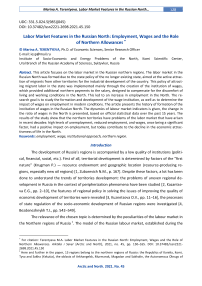Labor Market Features in the Russian North: Employment, Wages and the Role of Northern Allowances
Автор: Terentyeva M.A.
Журнал: Arctic and North @arctic-and-north
Рубрика: Northern and arctic societies
Статья в выпуске: 45, 2021 года.
Бесплатный доступ
This article focuses on the labor market in the Russian northern regions. The labor market in the Russian North was formed due to the state policy of the no longer existing state, aimed at the active attraction of migrants from other territories for the industrial development of the country. This policy of attracting migrant labor in the state was implemented mainly through the creation of the institution of wages, which provided additional northern payments to the salary, designed to compensate for the discomfort of living and working conditions in the North. This led to an increase in employment in the North. The research goal is to study the formation and development of the wage institution, as well as to determine the impact of wages on employment in modern conditions. The article presents the history of formation of the institution of wages in the Russian North. The dynamics of labour market indicators is given, the change in the ratio of wages in the North is presented, based on official statistical data over the past 15 years. The results of the study show that the northern territories have problems of the labor market that have arisen in recent decades: high levels of unemployment, reduced employment, and wages, once being a significant factor, had a positive impact on employment, but today contribute to the decline in the economic attractiveness of life in the North.
Employment, wage, institutional approach, northern region
Короткий адрес: https://sciup.org/148323179
IDR: 148323179 | УДК: 331.5.024.5(985)(045) | DOI: 10.37482/issn2221-2698.2021.45.150
Текст научной статьи Labor Market Features in the Russian North: Employment, Wages and the Role of Northern Allowances
The development of Russia’s regions is accompanied by a low quality of institutions (political, financial, social, etc.). First of all, territorial development is determined by factors of the “first nature” (Krugman P.) — resource endowment and geographic location (resource-producing regions, especially new oil regions) [1, Zubarevich N.M., p. 167]. Despite these factors, a lot has been done to understand the trends of territories development: the problems of uneven regional development in Russia in the context of peripherization phenomena have been studied [2, Kazantseva E.G., pp. 2–10], the features of regional policy in solving the issues of improving the quality of economic development of territories were revealed [3, Kuznetsova O.V., pp. 11–16], the processes of state regulation of the socio-economic development of Russian regions were investigated [4, Bezdenezhnykh T.I., pp. 542–549].
The relevance of the chosen topic is determined by the peculiarities of the labour market in the Northern regions of Russia 1. The model of the Russian labour market, established during the
1990s, does not correspond to the traditional one, which should and is able to adapt to external shocks due to changes in the level of employment (and, consequently, the level of unemployment) at a relatively inflexible price for labour — wages. The domestic labour market responded to the negative impact of external shocks with a rapid drop in wages on the condition of a slow decline in employment and lagging behind the rate of decline in production, while the labour market is able to maintain an equilibrium state [8, Varshavskaya E.Ya.]. Thus, the labour market adaptation to shocks is primarily due to wage flexibility. The labour market in the North of Russia, a strategically important macro-region with difficult natural and climatic conditions, has its own specifics. For example, the employment rate was higher: in 2019, it was 63.9% in the North, compared with 59.4% in Russia. The history of development of the North of Russia was associated with the industrial development of the Soviet economy, therefore, the state policy was carried out as part of the settlement and securing the population in the sparsely populated North. Due to the migration factor, the population of the northern regions grew steadily until the 1990s, but later, the population started leaving the North [5, Samarina V.P. et al.], as a result, the population decreased from 9135.0 thousand people in 1996 to 7820.01 thousand people in 2019, while the number of people employed in the economy declined by 7.3% over the period 1996–2019 [6, Mostakhova T.S.].
The northern territories are “relatively developed resource-producing regions with a high proportion of single-industry cities and towns”, therefore, unemployment in the North has increased values [7, Zubarevich N.M., p. 48]. In 2019, the unemployment rate in Russia as a whole was 4.6%, and the average for the northern regions was 5.6%. Unemployment in the regions of the European North is higher by 2.0–3.0%, while it is lower in the regions of the Asian North, thanks to the Khanty-Mansi (Yugra) and Yamalo-Nenets okrugs 2. The tension in the northern labour markets in 2019 amounted to 3.45 people of the unemployed population per one vacancy, while the Russian average is 2.1.
The socio-economic situation in the northern regions of Russia is characterized by a deterioration in the financial condition of enterprises, which contributes not only to the growth of unemployment, but also to the decline in the quality of social infrastructure, reduction of resource capabilities of local communities and regions as a whole and leads to lower living standards [9, Korchak E.A.], as well as limited financial and human resources [10, Korchak E.A.]. Therefore, the role of an effective wage institution is enormous. Further, this paper attempts to analyze the northern labour market from the position of its flexibility, focusing on how employment and wages have changed over the past 12–15 years.
Labour market flexibility
Interest in the problem of labour market flexibility has been renewed due to the continued imbalance in the markets for factors of production, including the labour market, which is fraught with underpricing of labour and overpricing of final products [11, Pissarides S.A.; 12, Solow R.M.; 13, Trevithick J.A.]. This situation in Russia is exacerbated by inefficient institutions, although economic practice shows that the costs incurred by economic entities to maintain a normal institutional environment and infrastructure do not correspond to those received in return, that is, the institutional rent transferred by economic agents in the form of taxes goes against the quantity and quality of services provided by the state. Such imbalances in institutional goods in the market adversely affect the overall economic equilibrium, further distorting the equilibrium prices for economic resources [14, Vishnevskaya N.T.].
Russian economists argue that the economic situation in the 1930s, which was studied by Keynes [15, Keynes J.M.], and the current situation in the Russian economy have many similar problems [16, Dzarasov S.S., pp. 18–22]. For example, the economic crisis of 2008–2009, according to the authors, is associated with an insufficient level of demand, the stimulation of which, combined with an increase in government spending, would eventually lead to a way out of it. Such policies allow solving the problems of unbalanced supply and demand for labour, inflexibility of the labour market, institutional failures (caused by institutional uncertainty, mismatch in the functioning of formal and informal norms, deficit or surplus of certain professions, etc.) [17, Manevich V.E., pp. 17–77]. The development of economic thought in solving institutional problems in both the economic and sociopolitical spheres has led to the fact that since the 1960s, the labour market has been studied from the perspective of institutional theory (T. Veblen, J. Dunlop, J. Commons, J. Galbraith, W. Mitchell). Institutionalist research deepens understanding of the influence of social and political institutions on labour markets. The institutional theory studies the behaviour of individuals (workers), which is irrational, so achieving an equilibrium state in the economic system is impossible. One way or another, when solving some economic issues, others will always emerge, connected with two postulates of institutional economic theory — limited human rationality and its inclination to opportunistic behaviour. But the solution of employment problems requires reforms in which it is necessary to take into account the behavioural aspects of a person as a worker [18, Veblen T.].
The existing rules of behaviour in the modern labour market are prescribed by a set of institutional restrictions [19, Commons J.R.], which determine the institutional properties of territorial labour market system functioning. Thus, the labour markets in the northern regions of the country, in comparison with other regions of Russia, have such institutional features associated primarily with a stricter regulation of wages, which leads to higher employer costs when hiring and firing employees, as well as increases the cost of workers due to additional charges to wages (northern and regional allowances).
The history of the wage institution in the North
The institution of wages began in the Soviet period, and until the end of the 1990s, wages were centrally regulated in the USSR. During the 70 years of Soviet government, the institution of wages in the northern regions has undergone changes. Workers and employees in the Far North and similar areas received labour benefits which tended to grow, fostering wage growth and providing greater social security, compensation, etc. As a result, the northern regions became attractive, people from other parts of the country started coming to the North for “easy money”, this increased the number of labour resources in the North. After the USSR collapse and the transition to market economic conditions, the northern and regional allowances were preserved. Thus, in 1991, the Decree of the Council of Ministers of the RSFSR “On Some Measures on SocioEconomic Development of the Northern Regions” 3was adopted: the regions were given the opportunity to solve the issue of coefficients when calculating wages.
Within the framework of the Decree of the Supreme Council of the Russian Federation of February 19, 1993 No. 4521-1 On the procedure for enacting the law of the Russian Federation “On State Guarantees and Compensations for People Working and Living in the Far North and Equated Localities” (Law on the North), the district coefficient and the percentage bonus to wages were determined. In paragraph 3 of this decree, state guarantees and compensations “apply to the regions of the North, in which the regional coefficient and the percentage increase in salary are charged, but not attributed to the regions of the Far North and areas equated to them”. Controversy arose as to which areas are referred to the North. It became clear that in the new market conditions, the accumulated contradictions in the development of the institution of wages need to be resolved. In 2002, the Labour Code of the Russian Federation was adopted, which did not lead to a decrease in the rigidity of Russian legislation on employment protection: the dismissal of workers is also associated with high financial and administrative costs. The Labour Code comprised a separate chapter on the regulation of the labour of people working in the Far North and in areas equated to it, and also provided for certain parts of the Labour Code: Article 59 (allows to execute a fixed-term employment contract to join organizations in the Far North and equated areas if it involves relocation to a new place of work), Article 116 (provides additional annual paid vacations, including for employees working in the regions of the Far North and areas equated to them) and Article 287 (indicates guarantees and compensations to people combining work with education, as well as persons working in the Far North and equated areas, provided to employees only at their primary work location). Since 2004, Chapter 50 of the Labour Code was amended, providing for the right of local authorities and employers of extra-budgetary sphere, taking into account the comments of trade union organizations, to establish additional guarantees and compensations independently. This made it possible to establish higher amounts of guarantees and compensation payments, the size of the district coefficient for institutions financed from regional and municipal budgets. Commercial enterprises introduced such payments through collective agreements, local regulations, labour contracts. It is worth noting that the experience of industrialized countries shows that among workers covered by collective agreements, wage inequality is more pronounced [20, Antonczyk D., DeLeire T., Fitzenberger B.]. It would seem that public sector employees are more protected by labour legislation, but domestic studies 4 indicate that, since the size of tariff rates (salaries), as well as incentive and compensation payments, are set based on the financial capabilities of the budgets of regions, municipalities and the employer. As a result, there is a strong differentiation of salaries both in the sectoral, and in the professional and qualification aspect.
The wage policy pursued by the Soviet state to attract the labour force for the industrial model of the economy can be called successful. Nevertheless, the radical change in the country's economy in the 1990s, accompanied by the decline of the industrial development model, did not lead to the abolition of the “northern compensation” to wages.
Institutional structure of the northern labour market
In the framework of the theory of compensating differences, the increase in the wage rate in the North should ensure high employment, despite unfavorable living conditions. Some researchers [22, Gimpelson V. et al., p. 138] point to a relatively “good situation” in the labour market of the northern regions, linking success with high employment rates. The dynamics of statistical data in fig. 1 indicates that, compared to the average Russian values, the level of employment in the Russian North is higher.

^™ Employment, Russia
Unemployment, Russia
^™ Employment, Russian North
^^^^^м Unemployment, Russian North
Fig. 1. The dynamics of employment and unemployment rates, % 5.
When comparing the northern regions in terms of employment, it can be noted that over the past 15 years, most of them have a positive trend (Fig. 2).
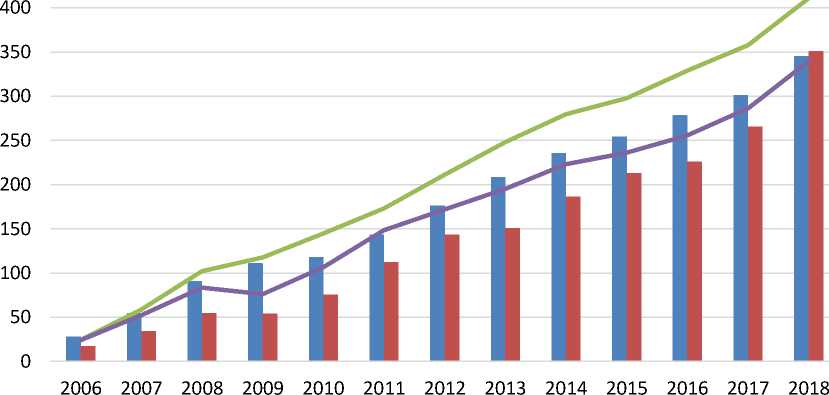
^™ Wage rates in the Russian North ^™ Productivity rates in the Russian North г' Productivity rates in the Russia г Productivity rates in the Russia
-
Fig. 2. The dynamics of the employment rate in the Northern regions of Russia, % 6.
The favorable employment trend is a consequence of the country's continued growth in the employment rate in 2000–2016. The Republic of Tyva had a significant increase in employment among the northern regions (an increase of 7.6, despite the lowest level of employment; it did not rise above 52.0% for 15 years), followed by Chukotka Autonomous Okrug (an increase of 7.2) and the Sakhalin Oblast (by 7.0). The highest employment rate in 2002–2018 was in Chukotka and Yamalo-Nenets Autonomous okrugs, while the lowest employment rates were observed in the Republics of Tyva and Karelia.
The demographic factor plays a significant role in the growth of employment in the North. Regions with a young age structure of the population are usually characterized by a large percentage of employed people aged 15–72. Accordingly, in most northern territories, the level of employment of the population is above the national average. The only traditional exception is Tyva, where young age structure is characterized by a low share of working-age population: below the national average (Table 1).
Table 1
The dynamics of share of working-age population in the northern regions of Russia, % 7
|
Working-age population in total population |
Employed population of working age in total population |
|||||
|
2010 |
2015 |
2019 |
2010 |
2015 |
2019 |
|
|
Russia |
61.5 |
57.4 |
56.3 |
47.3 |
48 |
49.3 |
|
European North |
||||||
|
Republic of Karelia |
61.1 |
56.1 |
54.8 |
52.4 |
46.2 |
43.6 |
|
Komi Republic |
64.5 |
59.0 |
57.3 |
53.9 |
49.8 |
49.0 |
|
Arkhangelsk Oblast |
61.3 |
56.1 |
55.1 |
50.7 |
50.3 |
45.1 |
|
Nenets Autonomous Okrug |
62.9 |
58.6 |
56.0 |
56.0 |
55.0 |
62.0 |
|
Murmansk Oblast |
65.3 |
60.6 |
59.6 |
59.2 |
52.4 |
49.1 |
|
Asian North |
||||||
|
Khanty-Mansi AO –Yugra |
68.8 |
63.2 |
61.0 |
55.7 |
56.3 |
64.7 |
|
Yamalo-Nenets AO |
70.1 |
66.2 |
64.3 |
59.4 |
70.6 |
77.9 |
|
Tyva Republic |
59.5 |
55.1 |
54.8 |
34.4 |
32.4 |
31.2 |
|
The Republic of Sakha (Yakutia) |
63.9 |
59.5 |
58.6 |
47.0 |
50.4 |
52.1 |
|
Kamchatka Krai |
65.4 |
61.9 |
61.0 |
59.0 |
58.3 |
53.5 |
|
Magadan Oblast |
66.3 |
61.1 |
60.1 |
60.9 |
59.9 |
65.7 |
|
Sakhalin Oblast |
63.5 |
58.6 |
57.5 |
54.1 |
58.6 |
57.2 |
|
Chukotka AO |
67.1 |
64.0 |
63.1 |
68.6 |
64.0 |
67.0 |
This difference is a consequence of the spread of temporary employment (including employment for several years), shift work, and migration of pensioners to regions with a favourable climate. The share of the working-age population and employed people in the working-age population in the northern regions is higher than the average for the Russian Federation.
The decline in employment in recent years is associated with a large-scale migration outflow, leading to a significant loss of both the total population and the working-age contingents. In the context of increasing birth rates and life expectancy in the 2000s, in the northern regions, there was a decrease not only in absolute numbers, but also in the share of the working-age population. Therefore, the problem of qualitative characteristics of labour resources will continue to aggravate here in the near future.
Figure 3 shows that during the crisis years (2008, 2014, 2018), labour market regulation was supported by flexible wages. Since the northern economy had a relatively smoothed trend during 2005–2019, only the 2008 crisis had a negative impact on the dynamics, it can be noted
-
7 Source: calculated according to Rosstat.
that the northern economy was able to adapt to external economic shocks. Employment grew slowly over the period 2005–2016, but since 2016, it started to decline, and the trends continue to the present. It should be noted that employment in the North did not suffer much during the 2008 and 2014 crises, there was a decrease in wages, i.e. due to that institutional mechanism, when under strict legislation, employers in times of crisis “sanitize” their economic situation not by dismissing employees (limit the high costs of dismissal — severance pay, etc.), but by reducing wages.
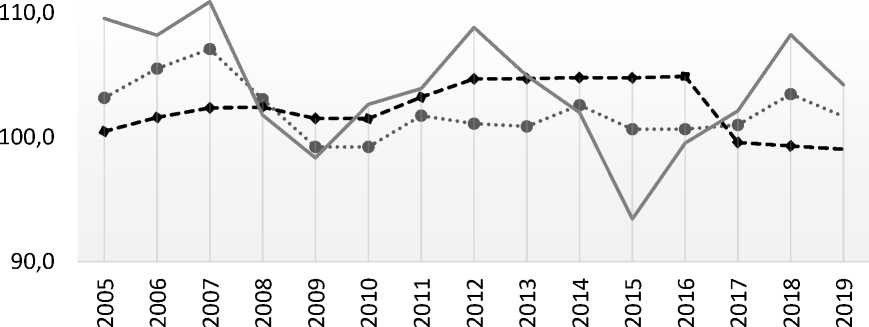
Gross Regional Product 4---- Employment Real wages
-
Fig. 3. The dynamics of the basic parameters of the labour market in the northern regions of Russia, % 8.
This affected labour productivity in the northern regions: for 12 years, the growth rate of labour productivity was lower than the growth rate of real wages; the dynamics of the two indicators in the North grew, but much more slowly than in the Russian Federation. By 2018, the rates of wages and labour productivity were almost equal (Fig. 4).
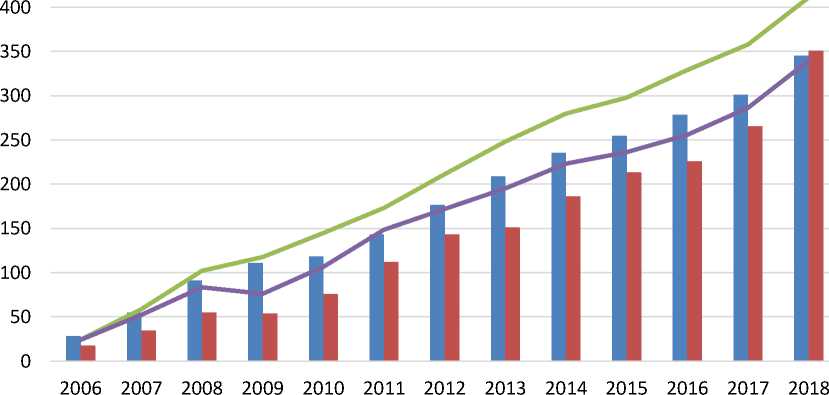
^™ Wage rates in the Russian North ^™ Productivity rates in the Russian North ^^^^^wProductivity rates in the Russia ^^^^^м Productivity rates in the Russia
Fig. 4. The dynamics of wages and labour productivity in the Russian North (compared to 2005) 9.
The data presented confirm that until 2018, the Russian North is characterized by outstripping real wage rates compared to labour productivity. Now the situation has changed, the growth rates of wages and labour productivity have leveled off. This is a consequence of a prolonged migration outflow of labour resources [23, Giltman M.A., et al.], which led to a shortage of qualified personnel [21, Korchak E.A. et al., p. 25]. Since the demand for qualified personnel is quite high, this leads to the fact that wages are growing, but labour productivity is falling. In turn, the decline in human capital hinders the improvement of social institutions (arising as a result of people's interaction in the process of social production), which becomes a serious obstacle to the growth of the northern economy.
Thus, the institutional structure of the labour market in the Russian North is also determined by high employment and unemployment. Some studies note that regions with higher unemployment rates tend to have higher wage inequality [24, Toksanbaeva M.S., p. 185], [25, Pi-lyasov A. N., p. 52], which can be explained by the behavior of job seekers, who evaluate at a low level the possibility of finding work with decent wages and agree to any low-paid work. In the northern regions of Russia, the dynamics of nominal wages (i.e. income due to the employee) over the last 15 years (Fig. 5) showed an increasing trend.
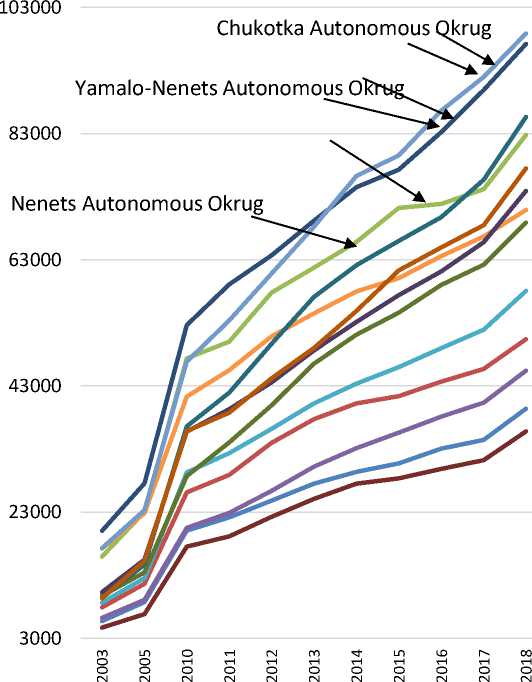
Republic of Karelia
^^^^^™ Republic of Komi
^^^^^■i Nenets Autonomous Okrug г' Arkhangelsk Oblast
^^^^^М Murmansk Oblast
Khanty-Mansiysk Autonomous Okrug-Ugra
^^^^^™Yamalo-Nenets Autonomous Okrug
^^^^^™Tyva Republic
' Republic of Sakha (Yakutia)
^^^^^М Kamchatka Krai
^^^^^е Magadan Oblast
' Sakhalin Oblast
^^^^^™Chukotka Autonomous Okrug
Fig. 5. The dynamics of nominal wages for 2003–2018 10
Among northern regions, the autonomous okrugs with a dominant extractive industry in the economy — Chukotka (mainly non-ferrous and precious metals production), Yamalo-Nenets and Nenets Autonomous okrugs (over 90.0% of industrial production is in the oil and gas sector) — lead in nominal wages. Wages are lower in the Tyva Republic and in the regions of the European North, whose territories belong to the old-developed territories: the Republic of Karelia, Arkhangelsk Oblast, Komi Republic and Murmansk Oblast. Nominal wages are often considered as “balancing” the demand and supply of labour, since it determines not only the levels of employment and unemployment, but also incentives to work and its quality [26, Belyavskiy M.O. et al.]. If nominal wages grow at an increasing rate in the Northern regions, there can (and should) be an increase in employment, reduction in the number of unemployed with a constant number of people employed, increase in employment with decreasing unemployment, reduction in the vacancy rate relative to the employment growth rate, which is greater than or equal to one. In fact, employ- ment growth was observed in Russia's northern regions until 2016, but the employment rate has been declining since 2017. Here, according to official data from Rosstat, the relatively constant number of employed decreased by 4.4% between 2010 and 2019, while the number of unemployed decreased by 37.0% over the same years. The growth rate of vacancies relative to the growth rate of employment is not decreasing: the growth in the number of vacancies by 9.0% was accompanied by an increase in employment by 5.0% in 2005, by 2019, the growth rate in the number of vacancies was 13.0% against 1.0% of the pace employment growth 11.
The regions of the Russian North lead in terms of wages compared to other regions of the Russian Federation, with the exception of the republics of Karelia and Tyva (Fig. 6).
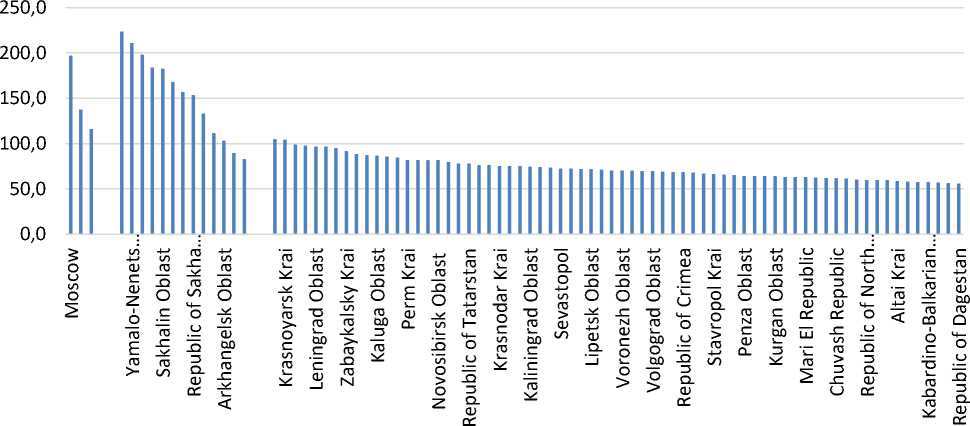
Fig. 6. The dynamics of the average nominal wages in the region (AW) in % of the average in the Russian Federation in 2019
In terms of wages, the city of Moscow (where this level is twice the average for Russia) is ahead of the autonomous okrugs of the Asian North — Chukotka and Yamalo-Nenets. However, the ratio of salaries in the northern regions and the average for the regions of Russia has decreased over the past 15 years (Fig. 7).
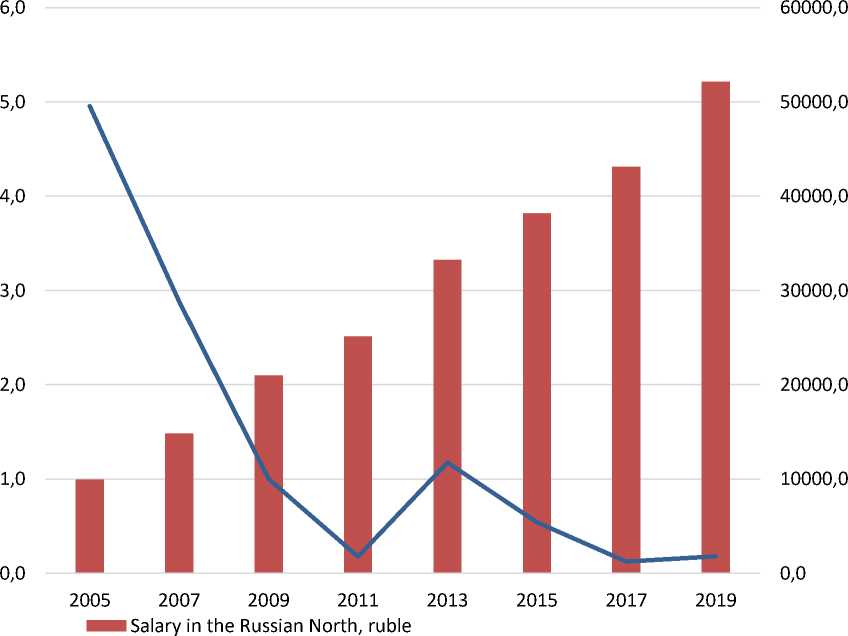
f The ratio of wages on average in Russia and in the north, %
Fig. 7. The ratio of wages in the North and the average for the regions of Russia for 2005–2018 12.
While in 2004 wages in the North were higher by 5%, then by 2019 the ratio decreased to 0.2%, which was primarily due to the abolition of restrictions on the amount of earnings on which northern compensation is accrued (regional coefficient and percentage surcharges).
Conclusion
Thus, the problems of employment in the Russian North for the period under review 2004– 2019 have worsened. The solution to these problems lies, among other things, in the organization of the institution of wages. The results of the study showed that wages are no longer an incentive factor in the growth of labour productivity. In fact, the market mechanism has destroyed the institution of wages. The North has ceased to be attractive for qualified personnel. Under such circumstances, the northern labour market will have to decide soon how to develop further in modern conditions. On the one hand, considering the fact of declining influence of the climatic factor (namely, new energy-saving technologies and their rapid development by people are currently the main competitive advantage of national economies; there are tendencies to reduce “climate costs”, and their share of GDP is decreasing), this is a “cardinal” way to change the existing situa-
12 Regiony Rossii. Sotsial'no-ekonomicheskie pokazateli, 2009–2019 gg. [Regions of Russia. Socio-economic indicators, 2009–2019]. URL: /catalog/doc_1138623506156 (accessed 24 November 2020). Author's calculations.
tion, requiring the construction of a new institution, the establishment of “new rules of the game” in the labour market. On the other hand, it is possible to maintain the status quo, reconsider the current situation, leave the existing institution of wages, add the necessary changes to the “rules of the game”. Otherwise, the result of the development of the Northern regions without changes and transformations would be a dead-end, since the resource abundance must contribute to the development of the Northern macro-region. Alternatively, in the near future, this deadlock could result in an immediate stagnation of the northern regions' economic development, which would in any case require the federal and regional authorities to make radical decisions.
Acknowledgments and funding
The article was prepared as part of the research project “The population of the northern territories of Russia: the history of formation and development prospects” (No. GR АААА-А19-119012190103-0, 2019–2021).
Список литературы Labor Market Features in the Russian North: Employment, Wages and the Role of Northern Allowances
- Zubarevich N.M. Regional'noe razvitie i regional'naya politika za desyatiletie ekonomicheskogo ros-ta [Regional Development and Regional Policy in Russia during Ten Years of Economic Growth]. Zhurnal novoy ekonomicheskoy assotsiatsii [The Journal of the New Economic Association], 2009, no. 1–2, pp. 161–174.
- Kazantseva E.G. Problemy regional'nogo neravenstva v Rossii [Problems of Regional Inequality in Russia]. Regional'naya ekonomika i upravlenie: elektronnyy nauchnyy zhurnal [Regional Economics and Management: Electronic Scientific Journal], 2019, no. 2 (58).
- Kuznetsova O.V. Regional'naya politika Rossii: diskussionnye voprosy sovremennogo etapa razvitiya [Regional Policy in Russia: Debatable Problems of Present Stage]. Regional'nye issledovaniya [Re-gional Studies], 2016, no. 4 (54), pp. 10–16.
- Bezdenezhnykh T.I., Makenov M.M. Sotsial'no-ekonomicheskoe razvitie regionov Rossii: problemy i puti resheniya [Socio-Economic Development of the Russian Regions: Problems and Solutions]. Re-gional'naya ekonomika: teoriya i praktika [Regional Economics: Theory and Practice], 2017, no. 3, pp. 541–552. DOI: 10.24891/re.15.3.541
- Samarina V.P., Skufina T.P., Samarin A.V. Russia's North Regions as Frontier Territories: Demograph-ic Indicators and Management Features. European Research Studies J., 2018, no. 3 (21), pp. 705–716.
- Mostakhova T.S. Regional'naya spetsifika vosproizvodstva naseleniya severnogo regiona i prioritety demograficheskoy politiki [Northern Region: Regional Particular Nature of Replacement of the Pop-ulation and the Demographic Policy Priorities]. Regional'naya ekonomika: teoriya i praktika [Re-gional Economics: Theory and Practice], 2017, vol. 15, iss. 4, pp. 784–798.
- Zubarevich N.M. Regiony Rossii: neravenstvo, krizis, modernizatsiya [Regions of Russia: Inequality, Crisis, Modernization]. Moscow, Nezavisimyy institut sotsial'noy politiki Publ., 2010, 160 p. (In Russ.)
- Varshavskaya E.Ya. Rossiyskiy rynok truda v usloviyakh ekonomicheskogo krizisa: transformatsiya modeli gibkosti? [Russian Labour Market under the Conditions of the Economic Crisis: Transfor-mation of Flexibility Model?]. Izvestiya Baykal'skogo gosudarstvennogo universiteta [Bulletin of Baikal State University], 2009, no. 4 (66), pp. 141–144.
- Korchak E.A. Blagosostoyanie naseleniya severnykh i arkticheskikh regionov Rossii [The Welfare of the Northern and Arctic Regions of Russia]. Sovremennye problemy nauki i obrazovaniya [Modern problems of science and education], 2013, no. 3.
- Korchak E.A. Trudovoy potentsial severnykh regionov v ramkakh realizatsii gosudarstvennoy politiki Rossiyskoy Federatsii v Arktike [Labor Potential of the Northern Regions in the Framework of the Russian State Policy Implementation in the Arctic]. Apatity, KSC RAS Publ., 2017, 178 p. (In Russ.)
- Pissarides S.A. The Need for Labor-Market Flexibility in a European and Monetary Union. Swedish Economic Policy Review, 1997, no. 4, pp. 513–546.
- Solow R.M. What is Labour-Market Flexibility? What is It Good for? Keynes Lecture in Economics, Proceedings of the British Academy, no. 97, pp. 189–211.
- Trevithick J.A. Involuntary Unemployment: Macroeconomics from a Keynesian Perspective Harvest-Wheatsheaf. London, 1992, 246 p.
- Vishnevskaya N.T. Gosudarstvennaya politika na rynke truda: reformirovanie institutov v stranakh OESR [State Labour Market Policy: Reforming Institutions In OECD Countries]. Voprosy gosudar-stvennogo i munitsipal'nogo upravleniya [Public Administration Issues], 2019, no. 1, pp. 35–60.
- Keynes J.M. The General Theory of Employment, Interest and Money. MacMillan, London, 1936.
- Dzarasov S.S. Kuda Keyns zovet Rossiyu? [Where is Keynes Calling Russia?]. Moscow, Algoritm Publ., 2012, 304 p. (In Russ.)
- Manevich V.E. Keynsianskaya teoriya i rossiyskaya ekonomika [Keynesian Theory and Russian Econ-omy]. Moscow, Editorial URSS Publ., 2010, 224 p. (In Russ.)
- Veblen Т. The Theory of the Leisure Class: An Economic Study of Institutions. New York, 1934, 400 p.
- Commons J.R. Institutional Economics. New York, Macmillan Publ., 1934.
- Antonczyk D., DeLeire T., Fitzenberger B. Polarization and Rising Wage Inequality: Comparing the U.S. and Germany. Econometrics, 2018, no. 6, pp. 20–21. DOI: 10.3390/econometrics6020020
- Korchak E.A., Skuf'ina T.P. Problemy i perspektivy sotsial'nogo blagopoluchiya arkticheskikh resur-sodobyvayushchikh gorodov Rossii [Problems and Prospects of Social Well-Being of Russian Arctic Resource-Extracting Cities]. Sever i rynok: formirovanie èkonomičeskogo porâdka, 2020, no. 1 (67), pp. 18–28. DOI: 10.37614/2220-802X.1.2020.67.002
- Rossiyskiy rynok truda: tendentsii, instituty, strukturnye izmeneniya [The Russian Labor Market: Trends, Institutions, Structural Changes]. Moscow, HSE Publ., 2017, 148 p. (In Russ.)
- Giltman M.A., Obukhovich N.V., Larionova N.I. Vliyanie zarabotnoy platy v evropeyskoy chasti Rossii na migratsiyu v rayonakh Kraynego Severa [The Impact of Wages in the European Part of Russia on Migration in the Far North]. Mir Rossii [Universe of Russia], 2020, no. 3, pp. 28–50. DOI: 10.17323/1811-038Х-2020-29-3-28-50
- Toksanbaeva M.S. Faktory formirovaniya vysokoy differentsiatsii zarabotnoy platy [Factors of For-mation of High Wage Differentiation]. Mezhdunarodnyy zhurnal gumanitarnykh i estestvennykh nauk [International Journal of Humanities and Natural Sciences], 2020, vol. 10-2 (49), pp. 184–191. DOI: 10.24411/2500-1000-2020-11144
- Pilyasov A.N. Arctic Entrepreneurship Development Factors. Geography, Environment, Sustainabil-ity, 2020, vol. 13, no. 1, pp. 46–56. DOI-10.24057/2071-9388-2019-91
- Belyavskiy M.O., Korovkin A.G., Polezhaev A.V. Rynok truda v Rossii i dinamika izmeneniya nomi-nal'noy zarabotnoy platy [Russia's Labor Market and Nominal Wage Dynamics]. Problemy prognozi-rovaniya [Studies on Russian Economic Development], 2000, vol. 11, no. 6, pp. 598–605.

